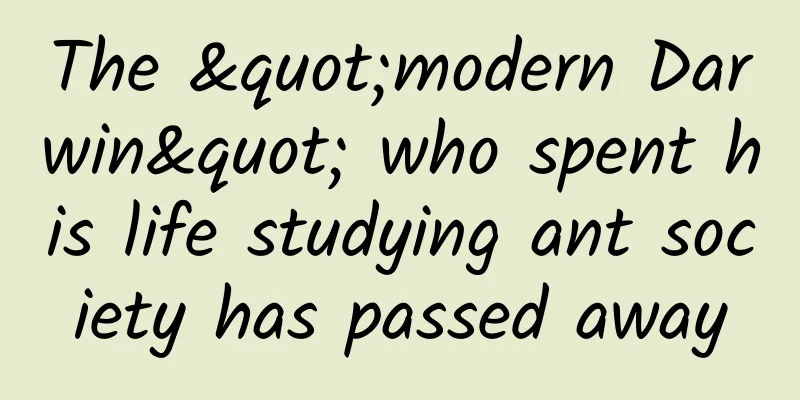The "modern Darwin" who spent his life studying ant society has passed away

|
This is what Calendar Girl wants to say Biologist Edward O. Wilson has died at the age of 92. Wilson was a leading figure in entomology, specializing in ants. He was the first to solve the mystery of ant pheromone communication, which became the inspiration for French science fiction writer Werbert to create "Ant Commonwealth". As remarkable as his academic achievements is his profound knowledge. In his book "Sociobiology", Wilson's knowledge of ants and even all animals comes to mind with ease, citing a wide range of references, which is very interesting. He also has a monograph on ants, which is thicker than a brick and weighs 3.4 kilograms. Edward Wilson | PLoS / Wikimedia Commons Wilson's rich knowledge is based on the richness of nature. Another focus of his research is biodiversity. He also wrote popular science books, calling on people to protect the ecology. Only by maintaining the complexity and richness of the biological world can humans have a happy future. Compared with Wilson's academic achievements, what impressed Calendar Girl the most was his love for the vastness and richness of the world, his heartfelt love for it, and his open mind to accept everything. He once said that his biggest dream was to come to a new planet with life, to understand and name everything there, but he should not only have a few years, but also centuries. If there is an Edward Wilson paradise, Calendar Girl would also like to visit it. The "destined" ant At the age of 16, Edward Wilson figured out that he wanted to study ants. He has loved studying animals since he was a child. When he was a child, he lived by the sea and was fascinated by jellyfish and fish. He set his ambition to become a biologist early on. But fate played tricks on him. He had hearing problems and could not hear high-frequency sounds, so he could not study animals that croaked happily, such as frogs. In addition, when he was 7 years old, he was accidentally blinded in his right eye by a fish fin while fishing. He could not see stereoscopic images with only one eye, so he could not observe animals that moved quickly, such as birds. Fortunately, God closes doors and opens windows. Wilson's left eye has better vision than ordinary people, which allows him to observe very small things. He can't hear the calls or see the movements clearly, but his superb ability to observe details has made him focus on insects as his research object. But there are thousands of insects in the world, which one should he study? Wilson in 1991 In the fall of 1945, 16-year-old Wilson began to seriously consider his future. "I must select some insects that can make me a world authority." First, butterflies were excluded because they were too famous and many outstanding scholars were studying them. Flies seemed more promising. They were everywhere and there were many species. Although houseflies and dung flies had ruined the reputation of dipteran insects, Wilson admired their neat posture and leisurely attitude. Wilson got down to work and prepared the tools: bottles, specimen boxes, and a special insect pin. Fate plays tricks on us again. This insect needle was mainly made in Czechoslovakia at the time. In 1945, Czechoslovakia joined the Soviet camp, and he could no longer buy this needle. So Wilson turned his attention to ants. For the past 50 million years, ants have been the overwhelming majority of insects on the surface of the earth, distributed on almost every inch of land. At this moment, there are at least 100 trillion ants living around humans. In this way, Wilson determined his lifelong research object at the age of 16. Young Authority and the Revenge of the Ants Since he made up his mind to study ants, Wilson dared to do anything. At the age of 25, he separated from his fiancée and traveled alone to the tropical rain forest of New Guinea. In order to collect special ants that were only found there, he endured the scorching heat, malaria, leeches, and even unknown murder fugitives. Ants of the genus Amblyopone are nicknamed "vampire ants" because they suck the hemolymph of larvae. Hemolymph is similar to vertebrate blood, but it is not used to transport oxygen, so a small loss is acceptable. | Renato Robert / Wikimedia Commons At the age of 26, Wilson graduated with a doctorate from Harvard, where he mainly studied the classification of ants. "Classification" is by no means a simple labeling of organisms. At that time, the person who had the right to classify organisms was often an authority on a certain species. They needed to thoroughly understand everything about the species in the literature, only in this way could they identify the selected species. A taxonomist could be described as the "general manager" and "spokesperson" of this type of organism. As someone who was already competent in ant classification, Dr. Wilson was offered a tenured position at Harvard University shortly after graduation. However, Wilson's ant research brought a "small disaster" to Harvard. One morning in the 1960s, a researcher in the Department of Biology's pipette stopped working. Upon closer inspection, it turned out that an ant had blocked the needle at the tip of the pipette. At lunch that day, many faculty members found small yellow ants on their sandwiches and hamburgers. The "disaster" was beginning to take shape. That afternoon, yellow ants appeared in glassware, file bags, and notebooks throughout the biology department. The ant colony was spreading in all directions through the cracks in the walls and pipes of the building. This yellow ant, called "Monomorium pharaonis," is an invasive species from the East Indies that can damage buildings and spread bacteria. Pharaoh ant (also known as Pharaoh's house ant) | Gao Qionghua/ Kunming Institute of Zoology, Chinese Academy of Sciences As you might expect, the Pharaoh ants escaped from Wilson's laboratory. The survival and reproduction ability of these ants is so strong that Harvard spent several years to gradually control their size. This "disaster" was jokingly called "the revenge of the ants" by Wilson. How to gather 100,000 ants? With the advancement of science and technology, people's observation range has gradually transcended the limitations of the five senses, and a new world has opened up before scientists. Biologists have discovered that most animals and plants can communicate by releasing chemical signals. These chemical signals are collectively called pheromones. Naturally, Wilson wanted to know how ants use pheromones to communicate? First, through dissection, he found that the Duchenne glands in ants might contain pheromones. However, how to analyze the composition of these pheromones was a big problem - the key substance in each ant was only one billionth of a gram. At that time, the most advanced analytical methods could identify trace substances of one millionth of a gram. In other words, 100,000 ants were needed to get the minimum dose required for the experiment. Where can you find so many ants? Wilson's rich experience came into play at this time. There is a kind of fire ant (Solenopsis invicta). When the river water rises and floods the ant nest, the worker ants will form a tight group and float on the water to protect the queen ant and the young ants to transfer safely. So Wilson drove to the southern countryside where fire ants are abundant. This place is simply the "Beijing, Shanghai and Guangzhou" of ants. The whole grassland is full of ant nests half a person high (fire ants are a very harmful invasive species, so Wilson can hunt them legally and reasonably here). Fire ants form clumps so strong that even tweezers can't break them apart | Scientific American / youtube Wilson's team members shoveled up the ant nest and put it into the ditch. After a while, the ants floated to the surface and huddled together. Everyone quickly used shovels to collect these ant balls. Of course, fire ants are not vegetarians. If you are stung by them, your skin will feel like it is burned by fire. If there is a chance, every ant in the ant nest wants to sting you dozens of times in a row. After being bitten by fire ants, Wilson finally collected enough materials and successfully completed the study of ant pheromones. A fork in the road for biology Where is evolutionary biology heading? Through the collection, classification and study of ant pheromones, Wilson had already realized his dream at the age of 16 - to become a world-class scholar in the field of biology. However, when he felt that he had reached the peak of his life, his field of evolutionary biology suffered a huge impact. The impact came from a brand new discipline - molecular biology. Molecular biology, as the name suggests, refers to the study of organisms at the molecular level. The founder and leader of this discipline is James Watson, a Nobel Prize winner and one of the discoverers of the double helix structure of DNA. James Watson (left) and Francis Crick (right), who discovered the double helix | Wikimedia Commons Watson, who became famous at a young age, was arrogant and believed that biology must be transformed into a science dominated by molecules and cells, and that biology must be rewritten using the language of physics and chemistry. Watson even believed that the biology established in the past was full of "people of mediocre intelligence". Molecular biology achieved a series of major results in a short period of time and became a great success. Almost overnight, everyone in the biological community had to talk about molecules, proteins, and DNA. Faced with the dominance of emerging disciplines, evolutionary biologists led by Wilson were not prepared to surrender to a group of "test tube operators" who could not even tell the difference between a red-eyed damselfly and a mole cricket. Wilson and his colleagues' counterattack was that it was undoubtedly a "stupid" approach to talk about biology without considering individuals, populations, and ecology. When the two factions were at their most deadlocked, Watson would not even say hello to Wilson when they met in the corridor. Long-knot weaver ants (Oecophylla longinoda) building a nest | Bernard DUPONT/ Wikimedia Commons Molecular biologists at this time were full of confidence and believed that the future belonged to them. Their goal was to solve scientific problems about life at the microscopic level, from molecules to cells to biological individuals, and to carry out a biological revolution from the bottom up. So, what breakthroughs could Wilson's evolutionary biology bring? After a long exploration, Wilson decided to bring biology to the social level. If someone falls into the water, will you save him? After decades of observing the lives of dozens of ants, Wilson formed his most important theory - sociobiology. Sociobiology is Wilson's theory to explain the social behavior of organisms from an evolutionary perspective. One of the famous achievements of this theory is the explanation of "altruistic behavior". Or in other words: "If someone falls into the water, will you save him?" The core of Darwin's theory of evolution is natural selection, and its object is the biological "individual". In theory, all creatures in nature should be self-interested, that is, "if someone falls into the water, you can't save them, so that you can survive." But obviously, this statement goes against common sense. The biological world is full of love and even selfless behavior. An ant of the genus Megaponera (Megaponera analis) is carrying larvae and cocoons. This ant will lick its injured companions to help them heal, and ants that are too seriously injured will actively "give up treatment" to avoid causing too much damage to their companions | ETF89 / Wikimedia Commons In order to explain this altruistic behavior, scholar William Hamilton proposed the "Kin Selection" theory: the purpose of altruistic behavior is to ensure that individuals with similar genes can survive. In other words, the object of natural selection is "genes." When someone falls into the water, whether to save them depends on blood relationship: If your own child falls into the water, you will try your best to save him; If an uncle or nephew falls into the water, they may not rescue him until the water is not deep enough; A stranger fell into the water and shouted for help on the shore. The closer the relationship, the stronger the altruism. Wilson disagreed with Hamilton in some ways. Wilson believed that "kin selection" meant that we had to "calculate" all the time. When we saw someone in danger, we had to check his family tree to see if he was a blood relative. Why are we willing to help complete strangers, or even sacrifice our lives? Think about the soldiers fighting on the front line, or the firefighters who risked their lives in the fire scene. They are completely protecting strangers. Dorylus ants marching along a path. Giant soldier ants protect the path | Mehmet Karatay / Wikimedia Commons To explain this phenomenon, Wilson built a mathematical model by studying the social behavior of ants and proposed another explanation for "altruistic behavior" - "group selection". The object of natural selection is not Darwin's "individual" or Hamilton's "gene", but the biological "group". Altruistic behavior occurs to ensure the survival of the "group" in which one is located. He also used experimental evidence to support this model: ants belonging to different lineages were placed in an ant nest and raised from childhood. These unrelated ants evolved a spirit of mutual help and dedication. In other words, it was not genes that initiated the altruistic behavior of ants, but the common growth of the group. Although Wilson did not invent the theory of group selection, he successfully demonstrated its rationality through mathematical and experimental methods. At present, there is still no consensus in the academic community on the difference between "kin selection" and "group selection". But Wilson's theory has undoubtedly found a new scientific perspective to answer this question. Long-knotted leaf-weaver ants (Oecophylla longinoda) work together to pull leaves together to form the foundation of their nest. | Sean.hoyland / Wikimedia Commons Wilson further extended the relevant theories to humans. From the perspective of sociobiology, he explained human social division of labor, kinship, class, gender division of labor, parent-child relationship, tribalism, nation-state, etc. In short, Wilson reinterpreted "human nature". Of course, once research touches on "human nature", it often causes a huge backlash: some people think that Wilson's theory provides soil for racism, and some people oppose inferring human behavior only from "lower animals" such as ants and bees. 137 scientists once jointly opposed Wilson's theory; during a public speech, opponents even poured cold water on Wilson. Wilson was prepared for the opposition. As a scientist, he felt that he had a responsibility to "think about some grand questions" and "establish a comprehensive and correct self-cognition (for humans). Looking back at Wilson's research career, he carefully studied everything about ants, and on this basis, he also wanted to peek into some of the mysteries of life. Whether it is right or not, Wilson has provided us with a possibility to re-understand ourselves. old age A few years ago, Wilson was interviewed in his garden. Before the reporter could say anything, the octogenarian Wilson leaned over, picked up an ant, and muttered to himself, "I have to find a small bottle to put it in and study it." Just like when I was 16. A passage from Wilson's autobiography Author: Round Square Editor: Yuki This article comes from I am a Scientist (ID: lamaScientist). Please contact the original author for reprinting. Feel free to forward to your circle of friends. |
>>: 90% of life depends on "talking"
Recommend
Case | Super practical SEM promotion case in the vocational training industry
This article shares with you the SEM promotion ca...
Super incentive system for gamified product operations
This article was first published in 2015. In rece...
The deputy mayor of Shanghai took the lead in taking off his mask and only recommended not wearing a mask in these occasions!
According to Oriental Net, on the afternoon of th...
Souwaifuwei SEO training course 132 (Baidu network disk)
Tonight’s topic is “Project planning to achieve r...
More practical APP ranking optimization methods and techniques
In recent years, it is not uncommon to see apps t...
Why do Emoji look different on different platforms?
Why does the same smiling emoji look so different...
Will scaling crack your teeth? The more you scale, the more problems you’ll have? Be sure to read these myths before scaling!
Teeth cleaning has become more and more popular i...
Look! There's a slippery "wireless mouse" in the desert
Today's species is very suitable for playing ...
Cold air is coming! Don’t wear your winter clothes directly from the bottom of the box, as it may cause...
Recently, cold air has hit Temperatures hit recor...
Technology Morning News | Shanghai adds 3 medium-risk areas
【Today’s cover】 Golden rays of light pierce throu...
BYD's monthly sales exceeded 300,000 units. Huawei is the key to achieving the goal of 4 million units next year
Data shows that BYD's auto sales in November ...
Exploring the dual-face of broadcasting and television: conservative industry promoters
As the entire OTT industry is declining due to th...
What are the most cost-effective APP promotion methods?
This topic is not my best, because most of my pre...
From air ticket bundling to child abuse, Ctrip betrays its values
Recently, two videos circulated online, showing t...
Fengxing intends to expand its super-dimensional ecosystem; investment alliances in the color TV industry have become a trend
"12 million units shipped in 3 years". ...









